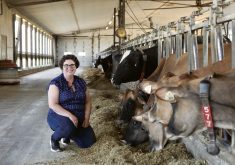It’s obvious that today’s farmers have upped their financial management game, working with professionals including accountants and lawyers to build on and execute plans that are miles more sophisticated than ever before.
But when it comes to marketing, are our farmers as good at roping in top advice?
It depends on the farm, of course, but many farms have done just that. They’ve made it part of an overall rethink as to how they approach commodity sales, tied in with a willingness to use different marketing tools and changing technology.
Read Also

Riding the tariff rollercoaster
Farmers are accustomed to roller-coaster years. But the current geopolitical windstorm is something else entirely. On his cattle operation near…
And often, it’s also tied in with a change in who makes which decisions.
Millennials flex their muscles
The proportion of farmers under the age of 35 has risen for the first time since 1991, Statistics Canada reported in its most recent census.
“There’s a new generation of farmer that’s coming on board, and it’s noticeable,” says Errol Anderson, president of ProMarket Communications in Calgary.
Among the big changes, says Anderson, is “a deeper respect for marketing.”
What difference is this new generation making on the ground? Anderson points to two concrete observations.
First, this new generation is actually taking over much of the decision-making in marketing. And second, they are demonstrating greater discipline.
These young Millennials, Anderson says, “are smart, they understand numbers, and they want to have control.”
Cargill market analyst Dave Reimann also sees a trend with younger farmers.
“We’re seeing a greater number of under-35 farmers than we had in many years, and they’re keener, more active and more willing to try things.”
Farming has become a lifestyle that has responsibilities requiring a business mindset, adds David Drozd, president and senior market analyst for AgChieve.
Even the basics get more attention. “You’ve got to know your break-even price per bushel so you know how much profit you’re making when you sell grain, or if it’s profitable if you sell it at that price,” Drozd says.
Marketing is hard work, and the more sophisticated farmers know exactly what they need for profit margin and are willing to be market disciplined to achieve that, agrees Frank Letkeman.
“It’s more of an approach to marketing than it is (wanting) to have a plan that will give them the highest price all the time,” says the 30-year grain industry veteran.
But are most doing this? The former elevator manager and territory manager with United Grain Growers and Agricore United doesn’t think so. Now with AgChieve, Letkeman reveals there continues to be an expectation that a simple plan that suits every individual’s needs perfectly is out there somewhere.
“I think most producers still continue to look for that perfect plan, thinking there’s got to be some way of making this easier. But really, there isn’t.”
More tools
Even so, a higher level of background sophistication has worked its way onto the farm. Whereas 20 years ago farmers might have focused their selling on a specific U.S. target — i.e. “beans in the teens” — growers’ strategies now have become more intricate, Anderson says.
Similarly, when Reimann first started directly working with farmers on grain marketing in 1986, he found very few did much forward contracting with grain companies and fewer still used futures. Options on futures weren’t even available.
“There were fewer tools and fewer people using them,” he says.
But over time he’s seen a gradual improvement in the number of tools available, and in the willingness of growers to use them.
“There’s so much more knowledge and active use of various marketing techniques that just didn’t exist back then,” Reimann says.
Marketing hat
On farms with multiple partners, Drozd is often seeing one person in the group aspire to the marketing side of operations. That seems to be the case with his clients, as his firm often deals with one partner more than the others.
Still, it’s hard to make generalizations. “There are some cases where there’s the one person that’s heavily involved in the decision-making and does most of it,” Reinmann finds. “There’s some where it’s very much a mix of the spouses, sometimes there’s the next generation involved, and with colonies, there may be multiple people involved in the decision-making.”
There can be positives and also challenges to either a single decision-maker or a committee. One person making the marketing decisions might arrive at a conclusion sooner, but they’re under more pressure to be right. With multiple people, it may be harder to reach a consensus, but there are more eyes doing the researching. Also, blame — and credit — get spread around.
Knowing if there’s an individual or team calling the marketing shots can help advisers understand which contracts an operation should use to fit their particular dynamic, Reimann says.
Internet driving change
The internet levelled the playing field for farmers through greater access to information, which in turn, has allowed them to make more informed marketing decisions.
“Farmers are very active users of tablet and smart phones, they’re live in the markets, and they use a lot of sources,” says Reimann, adding farmers even gather data from social media. “Twitter is a huge resource. They’re very, very engaged.”
Previously, market news arrived in a weekly newsletter while the latest data transmissions came at a high price, neither of which farmers could get to until the end of their work day.
“And now it’s right with you in the tractor,” Reimann says. “Technology has been an amazing improvement for growers.”
The amount of global information that’s coming to farmers hot off the press has changed attitudes, making operators more self-reliant.
“Growers realize the days of where a government will provide the backstop in farming, they are somewhat limited,” says Anderson. “Governments just don’t have that capability.”
Professional advice
Just having information on their phone, however, doesn’t automatically make a farmer a better marketer.They still need to know what to do with it. For that, the more sophisticated farmers are seeking professional marketing advice from advisory services and grain companies.
Besides, that flood of online information can be overwhelming, not to say conflicting: “On any given day, I can give you five reasons why the market should go up and five reasons why the market should go down, and sometimes it’s in the same article,” says Drozd.
And the stakes can be higher. With instant accessibility to news comes the market’s instant reaction, which can cause volatile price movements.
In some cases, farmers will hire an advisory firm to watch over news updates and let them know when the market’s direction might be changing.
“There’s no longer that time to hear the news and figure out what does it mean,” says Drozd.
Within Cargill is MarketSense, an intensive, hands-on consulting service in which farmers are advised about what’s happening in the grain markets and the contracting opportunities that might work best for their farm needs so they can come to a well-informed decision, Reimann says.
John De Pape, president at Farmers Advanced Risk Management, says farmers are seeking support.
In the hedge program he runs, he finds interest both from farmers with an aptitude for marketing as well as from those who’d prefer to leave it in someone else’s hands. The former understand markets and may have even done some hedging or futures trading on their own; the latter put their time somewhere other than marketing, but recognize there are methods they’re not familiar with that can exploit market opportunities.
Drozd adds that some of his clients who are knowledgeable about marketing like to use an independent, unbiased source as a sounding board before they pull the trigger on a sale.
But how do advisers convince farmers they’re the firm for them? That’s changed too, from in-person across a kitchen table or small coffee shop meetings and grain marketing courses.
“Along came technology,” Drozd says. “Things are changing.”
















